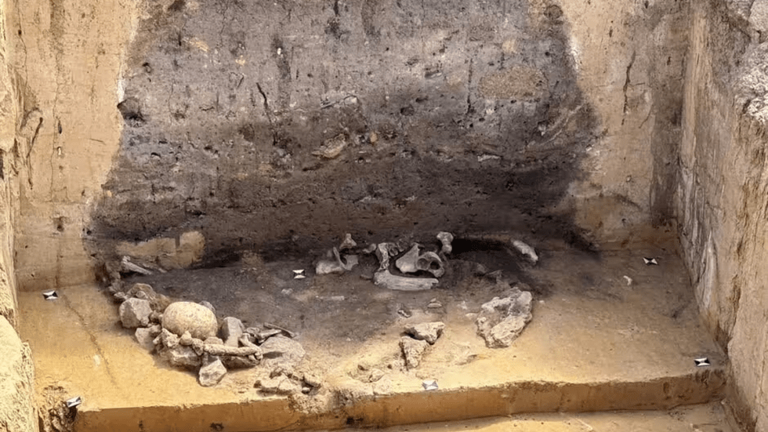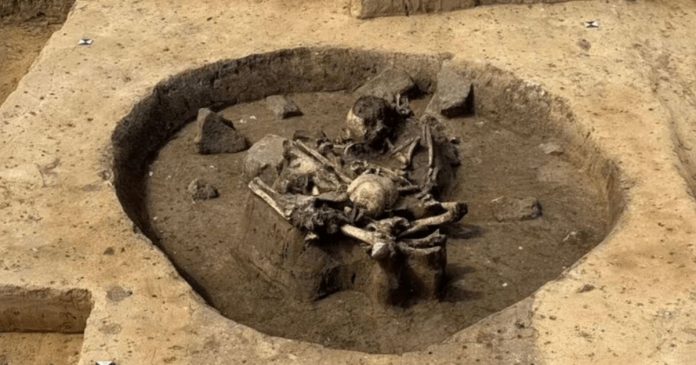Archaeologists uncover chilling ceremonial sites during modern infrastructure project, revealing a society’s spiritual response to upheaval.
Powerline Project Exposes Ancient Secrets
During preparatory work for Germany’s massive SuedOstLink powerline project (a 105-mile-long high-voltage transmission route), electrical workers near Gerstewitz, Saxony-Anhalt, uncovered twelve circular pits initially hidden beneath farmland. This accidental discovery halted construction and prompted a full archaeological excavation led by the State Office for Heritage Management and Archaeology Saxony-Anhalt, in collaboration with energy company 50Hertz. The pits, dating back 5,000 years (3400–3050 BCE), were identified as ritual sites created by the Salzmünde culture—a regional group within the broader Funnelbeaker cultural complex that inhabited the Saale River basin. This discovery adds significantly to understanding this enigmatic Neolithic society known for its complex death rituals.
Inside the Haunting Ritual Pits
Structural Design: Each pit measured 6.5–9.8 feet wide and 6.5–8.2 feet deep (2–2.5 meters), enclosed within a larger ditch system, indicating deliberate, significant construction efforts.

Ceremonial Contents: Archaeologists found a deliberate mix of materials:
- Charred Building Materials: Burnt remnants of house walls, including daub (loam), suggesting homes were intentionally burned, and rubble ceremonially deposited.
- Sacrificial Offerings: Intact, carefully placed ceramic vessels found in one pit, indicating their use in rituals rather than daily life .
- Animal and Human Remains: Dog bones (often found in anatomical order with signs of burning) and human skulls showing no weathering. One pit contained a dog skeleton beside a human skull.
- Converted Spaces: An ancient oven pit repurposed as a grave held two human individuals who had decomposed elsewhere before burial.
Evidence of Multi-Phase Mortuary Rituals
The arrangement and condition of remains point to prolonged, complex ceremonies:
- The juxtaposition of anatomically intact dog bones (exposed to fire) alongside an unweathered human skull in the same pit suggests these features were open for extended periods. Researchers propose the dog may have been buried first or preserved elsewhere before being placed alongside the later-added skull.
- The two bodies found in the repurposed oven pit showed signs of having decomposed at a different location prior to final burial. This indicates a funerary practice involving staged processes—temporary storage or display before internment.
- These findings align with known Salzmünde practices involving reburials, particularly skulls, and burial under layers of ceramic shards and burnt house debris, hinting at a cosmology deeply connected to ancestral veneration and transformation through fire.
Table: Key Features of the Gerstewitz Ritual Pits
| Feature | Description | Significance |
|---|---|---|
| Pit Dimensions | 2-3m wide, 2-2.5m deep; circular, within ditch system | Substantial effort; defined ritual spaces |
| Burnt Materials | Daub (loam), house rubble, horn cores | Deliberate burning of structures; symbolic inclusion of domestic life |
| Vessels | Complete ceramic pots, carefully placed | Sacrificial offerings; possible food/drink for afterlife |
| Dog Remains | Bones in anatomical order, often burned | Sacrifice; spiritual guides/protectors? |
| Human Remains | Skulls (unweathered), two bodies in oven pit (decomposed elsewhere) | Ancestor veneration; complex multi-stage mortuary practices |
| Repurposed Oven | Domestic feature converted into a grave | Blending domestic and sacred spheres; symbolic transformation |
A Culture Under Pressure: Climate and Conflict
Archaeologists interpret the intensity and nature of these rituals within a context of significant societal stress:
- Climate Instability: Paleoclimate data indicates Central Europe experienced cooler, erratic weather during the late 4th millennium BCE. This posed severe threats to the agricultural Salzmünde people, potentially causing crop failures and resource scarcity.
- Cultural Encroachment: Concurrently, the Bernburg culture began expanding southwards into Salzmünde territory from northern regions, likely increasing competition for land and resources and potentially sparking conflict.
- Ritual as Response: Facing environmental and social crises, the Salzmünde seemingly intensified complex rituals involving fire, sacrifice, and ancestral remains. Researchers theorize these practices were attempts to seek protection or intervention from ancestors or spirits during tumultuous times. The inclusion of dogs—animals often seen as mediators between worlds in ancient cosmologies—may reflect pleas for guidance or safety in the face of an uncertain future.
Modern Discovery Meets Ancient Mystery
While the Gerstewitz pits offer profound insights, they also underscore enduring questions. The precise symbolism behind burning homes, sacrificing dogs, or curating skulls remains elusive. Were these rituals communal events, tied to seasons, or reserved for elites? Future DNA and isotopic analysis of the bones may reveal relationships between individuals and origins of the animals, offering further clues. This discovery highlights how modern infrastructure projects, when conducted with careful archaeological oversight, can unexpectedly illuminate the deepest recesses of the human past. It paints a poignant picture of a resilient Neolithic society confronting crisis through complex spiritual practices, leaving behind haunting echoes of their struggle and beliefs for us to decipher millennia later.

